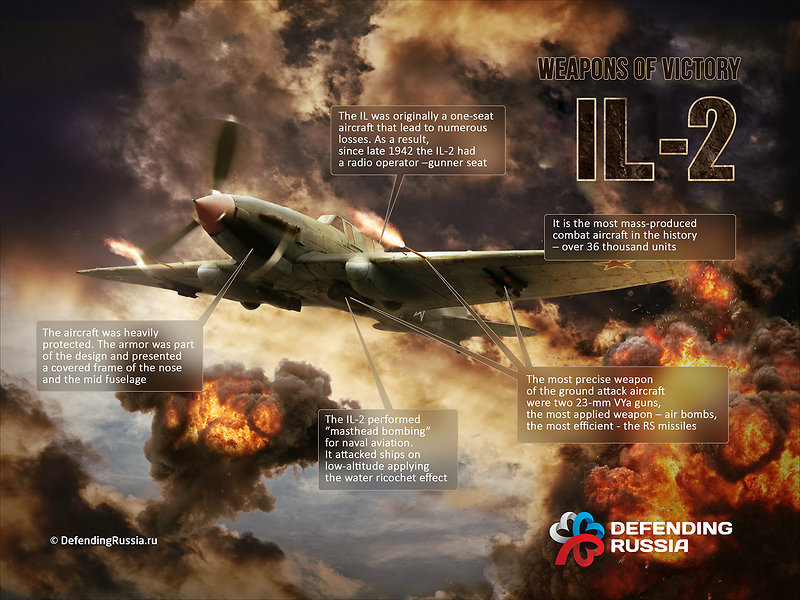IL-2 “Flying tank”
«The front needs the IL-2 planes as air, as bread» — Stalin wired to aviation factories' directors. In the initial period of War these simple attack planes made up the vast majority of the Soviet striking aviation. As for residual period, it was the IL-2 that provided close support of the troops, over and over again. 36 thousand planes is the all-time record of the world aircraft industry. This was the world most-produced battle plane.
At first, the Ilyushin designing bureau (DB) failed to complete the design assignment and developed a single-seated aircraft removing the gun post from the aft quadrant. That modification was put in serial production. As the war started there were lots of complaints from the army: the aircraft lacked maneuverability, could not conduct a combat plane-like battle and there was no apt quadrant protection. Having burnt themselves on the armored gear between the engine and the cockpit Germans «all of a sudden» felt for weak wooden tail and set to attack the ILs only from behind. Losses increased.
As a result, the DB pulled socks up and performed the IL-2 we’ve got used to i. e. the two-seater airplane equipped with the 12.7 mm turret machine gun for the crew gunner to protect the rear.
There is no need to pretend the IL-2 was a perfect aircraft. It had many disadvantages both of the construction and of manufacturing method and poor quality of material. The flying personnel learnt, as the saying goes, from their own mistakes. There was no time to waste: the front moved from Moscow to Stalingrad. The IL-2 was quite an organic and natural decision for the Soviet industry and the situation the Soviet Union was in. It really worked thus there was no disturbing it.
Operating the nonmaneuvering IL-2 was all the same a dangerous job. Weak-minded considered it a suicide. Alleging that you come upon some «Messers», you must give up all hope. Once, however, the strike pilots said to themselves: you can always find time to die, so, let’s accept the battle. Twice awarded Hero of the Soviet Union Georgi Parshin’s crew, for instance, killed 10 enemy’s aircraft during the 253 combat flights.
The slipping flight speed drop became the favorite maneuver. Due to overshooting, the enemy fighter aircraft was likely to receive in its tail the mixed salvo fire of the two 23 mm guns and two 7.62 mm ShKAS machine guns that were, as a rule, lethal. No wonder, as such combat power was originally intended for assaults i. e. striking more stable and solid ground-based objects.
It is believed, the IL-2 was called the «black death» in the Wehrmacht. The translation, by the way, is not quite accurate for the «plague» or «disease» words would match the case more. Germans themselves were of other opinion. They would call the IL-2 either «Il-Zwo» or the «cement-bomber» or «iron Gustav» for the low maneuverability and impenetrability. Being the main sufferer, the infantrymen gave it still more emotional nicknames, like the «butcher».
Throughout the War the IL-2 was the same thing for Germans as the Ju 87 dive-bomber was for us — a constant annoying problem falling from the skies. Attack aircraft and light bombers are weapons of the front line. What did the IL-2 fight with? With aircraft gun armament, bombs and rocket projectiles (RPs) of 82 and 132 mm caliber. The 23 mm VYa autocannons were the most precise weapon of the attack aircraft, bombs were the most lethal against common objectives.
The RPs is the inaccurate weapon and they were mainly applied in area attacks. Tough stories about tank sniper kills may be considered tales of the front or just accidents. The PTABs (Antitank Aviation Bombs) were good against tanks. The PTAB is a container for 48 small 2.5 kg of weight hollow-charge bombs. Having dropped the stock on a motor convoy an attack aircraft flight used to leave behind a chain of burning vehicles. Fragmentation and high explosive bombs were enough to cause damage to the infantry.
What is more, the IL-2 managed to combat above the sea! That was a forced step due to lack of combat radius and air-navigation equipment to fly over the sea. However, the IL-2 was rather good at fighting small and medium sea targets.
To do that it applied the «masthead bombing» method: bombs were thrown from the height of masts' tops, thus the name. Bombs used to ricochet on the water and hit the ship’s board. If lucky, it caused the underwater damage, which lead to heavy destruction and compartments flooding.


Orphus system